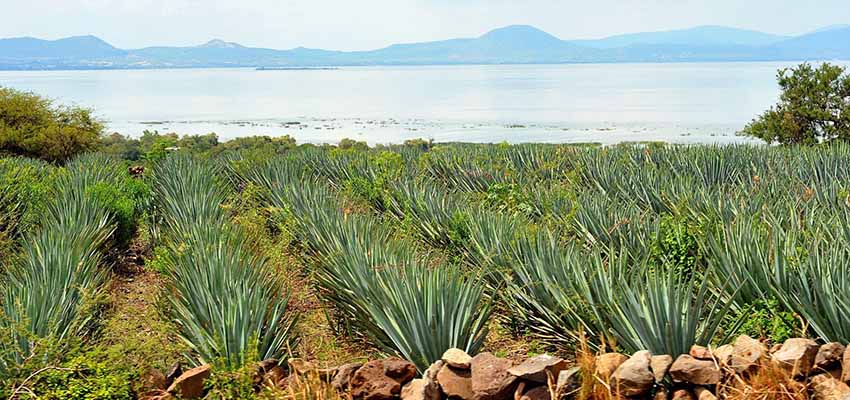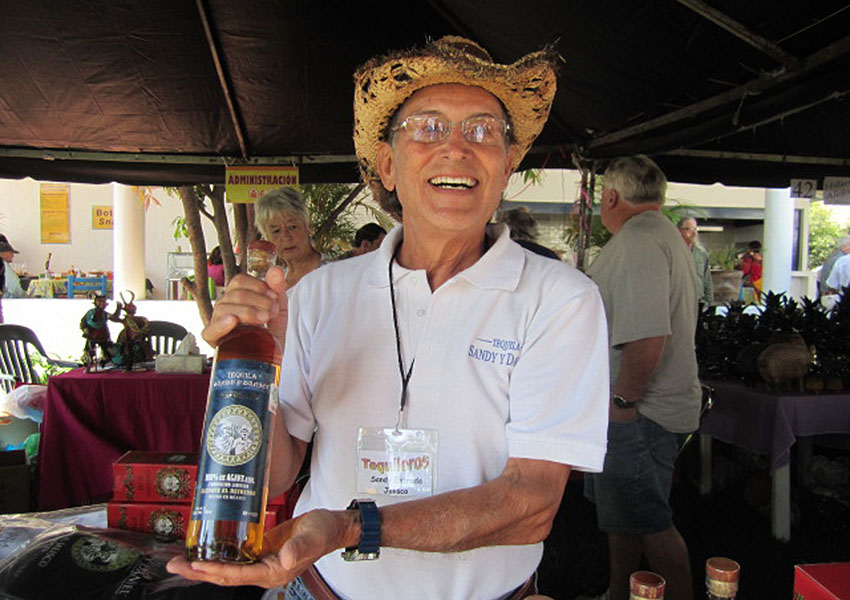In the last couple of years, questions like these have popped up every now and then on expat social media groups around Lake Chapala: “Does anyone know where to buy Sandy & Daniel tequila?” “Are Sandy & Daniel still selling their tequila?”
To understand why it’s so hard these days to find this tequila that’s a favorite of the foreign population around Lake Chapala, you have to take into account the wider forces in the tequila market. For instance, you may have noticed that in Mexican supermarkets and liquor stores, there is almost no real tequila on the shelves — and what real tequila exists is locked up in special cases.
The worldwide thirst for tequila has priced many Mexicans out of their signature drink. It also has put severe pressure on small producers like the Sandy & Daniel brand.
First, let’s talk about the brand’s creation, which was a bit of an accident: Robert (Sandy) Estrada and Daniel Ruiz’s partnership came through a chance meeting.

Los Angeles-born Estrada was staying in the Chapala area with a friend, and Ruiz was working there as a gardener. The two formed a fast friendship, with Estrada as best man at Ruiz’s wedding and godfather to subsequent children.
Because of this familial relationship, when Ruiz’s grandfather needed to sell his farmland in the late 2000s, he accepted Estrada’s proposal to buy it, making him a partner in the family’s blue agave-growing business.
But soon afterward, a major bust hit the agave market, making the crop — seven years in the making — worthless.
But instead of destroying it, Estrada suggested that they harvest anyway, contracting with a distillery in Tequila to make, if nothing else, a batch to share with family and friends. That 20 tons of agave turned into far more cases than they could ever drink, so the business partners looked for ways to sell it in the local area.
The two had experienced one end of the wild boom-and-bust cycle of tequila agave production. Despite the liquor’s huge popularity, there are still problems with farmers planting agave because of currently-high prices versus making educated guesses about the markets six to seven years later. Years of effort can be lost, as well as opportunities to cash in on boom markets.
The ever-growing popularity of tequila lengthens this cycle but does not eliminate it. The need to time planting and harvesting has become even more critical not only because of federal and state tax issues but also the fact that growing, harvesting and selling is heavily regulated by the tequila regulation council, Consejo Regulador de Tequila (CRT).
But through trial-and-error, Estrada and Ruiz found that they had a market for their product among the large and interconnected foreign population around Lake Chapala. Promoted at local events, the smooth tequila became a hit, as well as the story of a partnership between a local farming family and an expat. By the time the pandemic hit, Sandy & Daniel had a very strong regional market and had even gained recognition in Jalisco and California.
But the pandemic and the steady rise in agave prices took their toll. Sandy & Daniel lost their main source of sales through tasting events to COVID restrictions. Since they made their first batch, blue agave prices went from near-zero to as much as 35 pesos today. Predictions since 2018 of gradual decreases have not materialized, and most distillers are not holding their breath.

The prices for agave are a result of demand, rather than a lack of supply. Tequila originally was a poor man’s drink, something made with “useless” agave growing wild. Its ever-growing worldwide popularity has made it a specialty, taking it out of its traditional markets into silver-decorated bottles named and promoted by celebrities.
The worldwide demand for agave means that major distillers are now eschewing traditional techniques in favor of large industrial machines and even chemicals that allow them to use agave plants before they mature. They have also bought land for growing their own agave to help mediate price fluctuations. Most importantly, with costs so high, it is almost now impossible to stay in the tequila business without exporting.
Today, over 80% of Mexico’s tequila is sold outside the country.
Estrada and Ruiz did consider exporting and began the process, but they found the upfront costs and risks too high. They also decided that they did not want to go the more modern production route. Both have had serious effects on the business. Despite having a relatively affluent foreign community on their doorstep, it is not large enough to sustain them.
To survive, the two have diversified their business activities into other areas such as real estate, but, ironically, they are back to where they started over a decade ago. They have expanded their fields and now focus on producing agave to “…sell to the big boys…” the family’s original business plan. It’s still not without its risks. Agave farms have been experiencing consolidation. In the 1990s, there were about 25,000 growers in the permitted areas for blue agave. Today, the number of cultivators is less than 10% of that.
Emotionally, Sandy and Daniel are still tied to the idea of producing tequila, even though none is currently being made under their label. They built a tequila tasting room on top of a hill overlooking Lake Chapala, where they will be developing homes.
But the future of Sandy & Daniel tequila is murky at best. Due to a longstanding relationship with Chapala’s famous Feria de Maestros de Arte, the two will be selling from the last of the cases they have, both to support the organization behind the handcrafts fair and to celebrate the winding down of the pandemic. It is likely your last opportunity to buy the product for a very long time.
Leigh Thelmadatter arrived in Mexico 18 years ago and fell in love with the land and the culture in particular its handcrafts and art. She is the author of Mexican Cartonería: Paper, Paste and Fiesta (Schiffer 2019). Her culture column appears regularly on Mexico News Daily.
